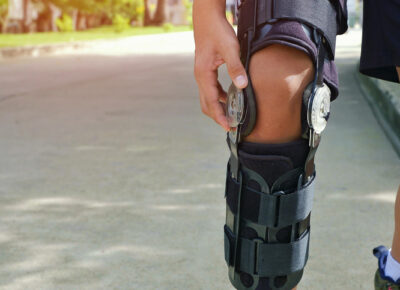An anterior cruciate ligament (ACL) tear is an injury to the knee commonly affecting athletes. Nonathletes can also experience an ACL tear due to injury or accident. It is estimated that there are 95,000 ruptures of the ACL and 100,000 ACL reconstructions performed every year in the United States. Approximately 70% of ACL tears in sports are the result of noncontact injuries, and 30% are the result of direct contact (player-to-player, player-to-object). Women are more likely than men to experience an ACL tear.
Everest Rehabilitation physical therapists are trained to help individuals with ACL tears reduce pain and swelling, regain strength and movement and return to desired activities.
Once an ACL tear has been diagnosed, you will work with your surgeon and physical therapist to decide if you should have surgery, or if you can recover without surgery. If you don’t have surgery, Everest Rehabilitation physical therapists will work with you to restore your muscle strength, agility and balance, so you can return to your regular activities. Your physical therapist may teach you ways to modify your physical activity to put less stress on your knee. If you decide to have surgery your physical therapist can help you before and after the procedure.
Treatment Without Surgery
Current research has identified a specific group of patients who have the potential for healing without surgery following an ACL tear. These patients have injured only the ACL and have experienced no episodes of the knee “giving out” following the initial injury. If you fall into this category, based on the specific tests your physical therapist will conduct, your therapist will design an individualized physical therapy treatment program for you.
Treatment Before ACL Surgery
If your orthopedic surgeon determines that surgery is necessary, your Everest Rehabilitation physical therapist can work with you before and after your surgery. Some surgeons refer their patients to a physical therapist for a short course of rehabilitation before surgery. Your physical therapist will help you decrease your swelling, increase the range of movement of your knee and strengthen your thigh muscles (quadriceps).
Treatment After ACL Surgery
Your orthopedic surgeon will provide post-surgery instructions to your physical therapist, who will design an individualized treatment program based on your specific needs and goals. Your treatment program may include:
Bearing weight
Following surgery, you will use crutches to walk. The amount of weight you are allowed to put on your leg and how long you use the crutches will depend on the type of reconstructive surgery you have received. Your physical therapist will design a treatment program to meet your needs and gently guide you toward full weight bearing.
Icing and compression
Immediately following surgery, your physical therapist will control your swelling with a cold application, such as an ice sleeve, which fits around your knee and compresses it.
Bracing
Some surgeons will give you a brace to limit your knee movement (range of motion) following surgery. Your physical therapist will fit you with the brace and teach you how to use it safely. Some athletes will be fitted for braces as they recover and begin to return to their sports activities.
Movement exercises
During your first week following surgery, your physical therapist will help you begin to regain motion in the knee area and teach you gentle exercises you can do at home. The focus will be on regaining full movement of your knee. The early exercises help with increasing blood flow, which also helps reduce swelling.
Electrical stimulation
You may receive electrical stimulation to help restore your thigh muscle strength and help you achieve those last few degrees of knee motion.
Strengthening exercises
In the first 4 weeks after surgery, your physical therapist will use a combination of weight-bearing and non-weight-bearing exercises to help you increase your ability to put weight on your knee. The exercises will focus on your thigh muscles (quadriceps and hamstrings) and might be limited to a specific range of motion to protect the new ACL. Over time, you may increase the intensity of your exercises and add balance exercises to your program.
Balance exercises
We will guide you through exercises on varied surfaces to help restore your balance. Initially, the exercises will help you gently shift your weight on to the surgery leg. These activities will progress to standing on the surgery leg, while on firm and unsteady surfaces to challenge your balance.
Return to sport or activities
As athletes regain strength and balance, they may begin running, jumping, hopping or other exercises specific to their individual sport. This phase varies greatly from person-to-person. Everest Rehabilitation Services physical therapists design return-to-sport treatment programs to fit your individual needs and goals.

